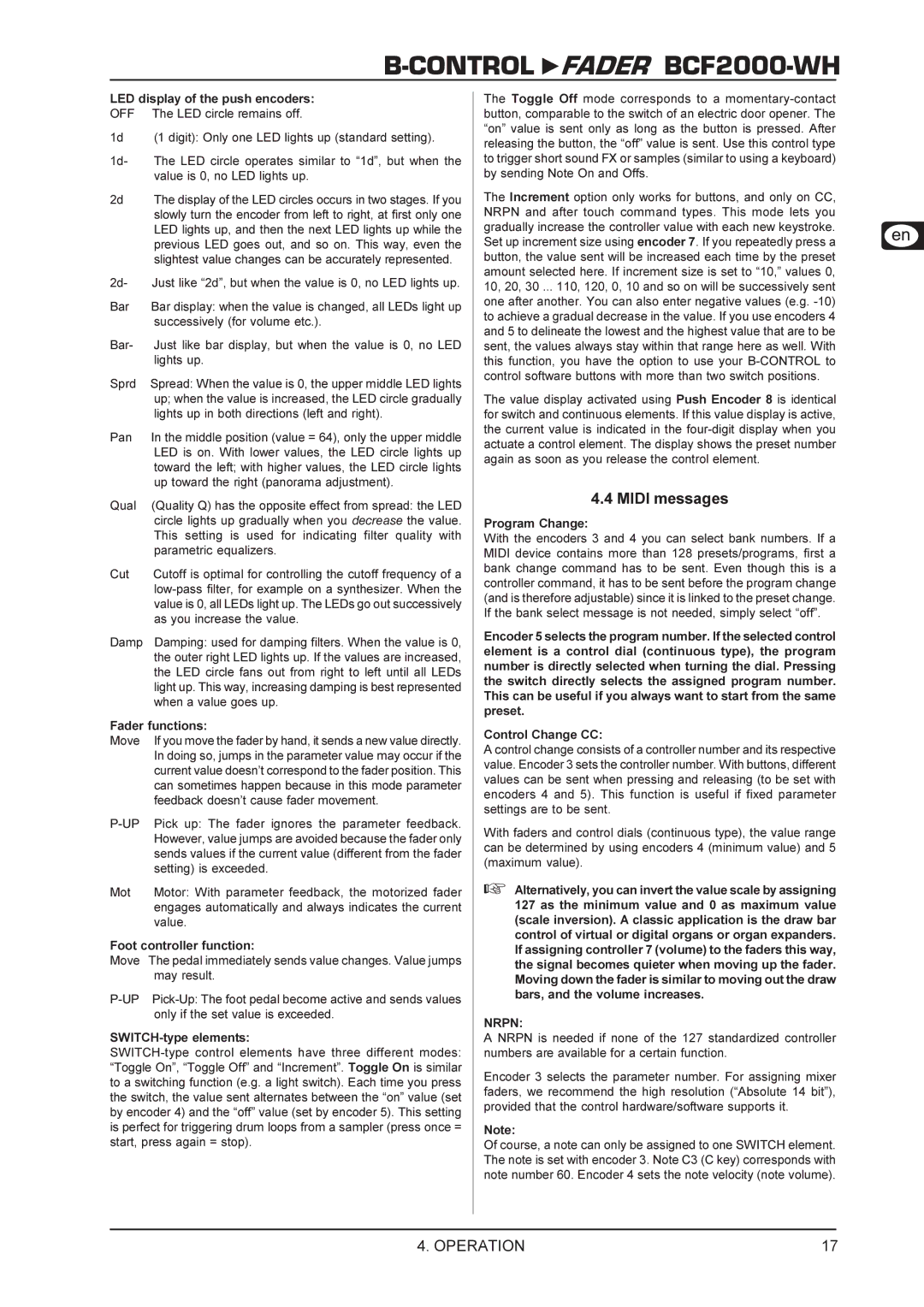
B-CONTROL  FADER
FADER BCF2000-WH
LED display of the push encoders:
OFF The LED circle remains off.
1d | (1 digit): Only one LED lights up (standard setting). |
1d- | The LED circle operates similar to “1d”, but when the |
| value is 0, no LED lights up. |
2d | The display of the LED circles occurs in two stages. If you |
| slowly turn the encoder from left to right, at first only one |
| LED lights up, and then the next LED lights up while the |
| previous LED goes out, and so on. This way, even the |
| slightest value changes can be accurately represented. |
2d- | Just like “2d”, but when the value is 0, no LED lights up. |
Bar | Bar display: when the value is changed, all LEDs light up |
| successively (for volume etc.). |
Bar- Just like bar display, but when the value is 0, no LED
| lights up. |
Sprd | Spread: When the value is 0, the upper middle LED lights |
| up; when the value is increased, the LED circle gradually |
| lights up in both directions (left and right). |
Pan | In the middle position (value = 64), only the upper middle |
| LED is on. With lower values, the LED circle lights up |
| toward the left; with higher values, the LED circle lights |
| up toward the right (panorama adjustment). |
Qual | (Quality Q) has the opposite effect from spread: the LED |
| circle lights up gradually when you decrease the value. |
| This setting is used for indicating filter quality with |
| parametric equalizers. |
Cut | Cutoff is optimal for controlling the cutoff frequency of a |
| |
| value is 0, all LEDs light up. The LEDs go out successively |
| as you increase the value. |
Damp | Damping: used for damping filters. When the value is 0, |
| the outer right LED lights up. If the values are increased, |
| the LED circle fans out from right to left until all LEDs |
| light up. This way, increasing damping is best represented |
| when a value goes up. |
Fader functions:
Move If you move the fader by hand, it sends a new value directly. In doing so, jumps in the parameter value may occur if the current value doesn’t correspond to the fader position. This can sometimes happen because in this mode parameter feedback doesn’t cause fader movement.
Mot | Motor: With parameter feedback, the motorized fader |
| engages automatically and always indicates the current |
| value. |
Foot controller function:
Move The pedal immediately sends value changes. Value jumps may result.
The Toggle Off mode corresponds to a
The Increment option only works for buttons, and only on CC, NRPN and after touch command types. This mode lets you gradually increase the controller value with each new keystroke. Set up increment size using encoder 7. If you repeatedly press a button, the value sent will be increased each time by the preset amount selected here. If increment size is set to “10,” values 0, 10, 20, 30 ... 110, 120, 0, 10 and so on will be successively sent one after another. You can also enter negative values (e.g.
The value display activated using Push Encoder 8 is identical for switch and continuous elements. If this value display is active, the current value is indicated in the
4.4 MIDI messages
Program Change:
With the encoders 3 and 4 you can select bank numbers. If a MIDI device contains more than 128 presets/programs, first a bank change command has to be sent. Even though this is a controller command, it has to be sent before the program change (and is therefore adjustable) since it is linked to the preset change. If the bank select message is not needed, simply select “off”.
Encoder 5 selects the program number. If the selected control element is a control dial (continuous type), the program number is directly selected when turning the dial. Pressing the switch directly selects the assigned program number. This can be useful if you always want to start from the same preset.
Control Change CC:
A control change consists of a controller number and its respective value. Encoder 3 sets the controller number. With buttons, different values can be sent when pressing and releasing (to be set with encoders 4 and 5). This function is useful if fixed parameter settings are to be sent.
With faders and control dials (continuous type), the value range can be determined by using encoders 4 (minimum value) and 5 (maximum value).
+Alternatively, you can invert the value scale by assigning 127 as the minimum value and 0 as maximum value (scale inversion). A classic application is the draw bar control of virtual or digital organs or organ expanders. If assigning controller 7 (volume) to the faders this way, the signal becomes quieter when moving up the fader. Moving down the fader is similar to moving out the draw bars, and the volume increases.
NRPN:
A NRPN is needed if none of the 127 standardized controller numbers are available for a certain function.
Encoder 3 selects the parameter number. For assigning mixer faders, we recommend the high resolution (“Absolute 14 bit”), provided that the control hardware/software supports it.
Note:
Of course, a note can only be assigned to one SWITCH element. The note is set with encoder 3. Note C3 (C key) corresponds with note number 60. Encoder 4 sets the note velocity (note volume).
4. OPERATION | 17 |
